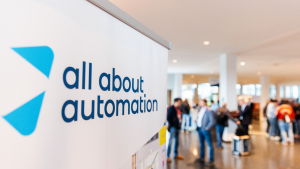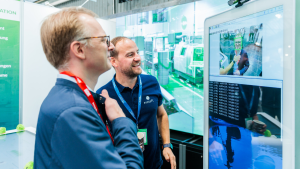
evosoft at the “REWIREcable Conference 2025” in Amsterdam
On June 3 and 4, 2025, it’s time: The REWIREcable Conference 2025 in Amsterdam will bring together professionals and executives from the international cable industry to
Realize the full potential of your data by successfully integrating IT and OT into your operations and intelligently connecting your networks. Integration can be a challenge at the beginning, especially in medium-sized companies, but if implemented correctly, it can unleash extraordinary growth. By implementing suitable IoT solutions, you create an intelligent networked foundation to optimize your business processes and increase the benefits of your data. We will show you the challenges that need to be overcome and how to successfully connect your IT and OT networks.
On the road to digital transformation and technology-based future of an operation, IT-OT connectivity is one of the most important steps. Connecting information technology (IT) with operational technology (OT) enables efficient use of the data generated in your operation. IT-OT network connectivity means linking plant or machinery automation with IT as seamlessly and fully as possible. In the process, smart sensors and advanced technologies are collecting a lot of data on all the assets and machines that are connected through the Internet of Things (IoT). IoT devices are becoming smarter, more connected and more useful as more innovative technologies and sensors generate valuable smart data. Based on this data, analyses can be performed that reveal optimization potential in production and new services for OT.
The digitization of production enables new digital products, which in turn can lead to new business models and secure and expand your competitive position. This combination of IT and OT offers companies numerous advantages such as increased performance, productivity, flexibility or sustainability. The continuous evaluation of this data increases the transparency of ongoing operations and enables reliable, data-driven decisions. However, in addition to the technical connection of the two networks, interpersonal interaction also plays an essential role. Instead of operating in parallel, IT and OT departments need to break down existing silos together and share their respective expertise with the know-how of the other.
Secure communication and thus data exchange between IT and OT form the cornerstone for the further digitization of a company. Uniting these two worlds and deriving valid useful data from them is the overarching goal of IT-OT connectivity. Successful connection therefore means the merging of store floor and top floor in the Industrial Internet of Things (IIoT). If the successful connection of IT and OT creates a smooth flow of data between the domains, a fusion is enabled that allows all the benefits of IT and OT connectivity to be fully realized. The benefits of introducing IoT technologies include a significant increase in quality, cost efficiency and improved competitiveness, especially in the area of production.
The integration and successful connection of IT and OT networks are not in themselves the primary goal, but they are the basis for future business and a prerequisite for the digitalization of tomorrow’s production. It enables the exchange and collaboration of existing networks and data and provides the ability to monitor, control and improve your systems and production. Furthermore, higher quality data management within your own operations creates new opportunities to improve business processes across plant and machinery, and even automate workflows. Without this integration and connectivity, it will be nearly impossible to effectively and efficiently operate and manage the reliability and resilience of the network with all its ongoing changes.
However, there are various challenges in this process that medium-sized companies in particular must be aware of and successfully overcome when connecting their IT and OT layers in order to ensure that their IT and OT networks are successfully connected. Several steps are necessary to achieve this. A common understanding of all requirements and thorough planning of the implementation is particularly important. But just as essential is the use of suitable IT solutions and industrial-grade hardware at the OT level to avoid operational downtime or other disruptions in production from the outset.
Mutual understanding of the respective requirements is particularly important here. While in the IT area it is primarily important to ensure cybersecurity, at the OT level the permanent and constant availability of the network and thus of the entire production and all systems as well as machines is essential in particular. The specific requirements in each case must be taken into account before the connection is made in order to rule out any mutual interference from the outset and guarantee smooth operation.
Likewise, precise planning of the shared network infrastructure must be carried out. Since networks for offices or data centers are planned under different conditions than networks for automation in plants, a precise and individually adapted procedure is necessary. To ensure a successful connection, a thorough inventory of the network infrastructure of both levels in operation must therefore be made during preparation. The focus of the implementation should therefore be adapted to the respective industry-specific recommendations and standards, for example from the process industry, healthcare or discrete manufacturing.
Another important prerequisite for the successful connection of IT and OT are comprehensive OT and IT security concepts that protect the networks against unauthorized access from outside. For example, zero-trust solutions can be used to grant restricted access rights to the OT environments for a limited number of authorized users. It is important that the automation environment is connected to the security structures in the office area via protected firewalls at the transition between IT and OT. It must also be checked whether there are special requirements such as remote access to machines and systems. These must be checked and taken into account at an early stage in the security requirements.
In order to ensure that the two networks are connected consistently and that the respective requirements are met, it is also necessary to take into account other factors such as the constant changes in the IT environment, divergent industry standards, or the different age or condition of the machines and systems. For more than 25 years, our experts have been providing you with certified expertise and a broad range of digitization services to help you meet your individual requirements on the way to digitized operations.
Would you like to take the first step towards digital connectivity for your company, but don’t know how best to start? We will support you step by step and show you initial measures as well as a possible roadmap for digitizing your machines, plants and components.
To ensure that the connection of your IT and OT networks does not have a negative impact on performance on the top floor or availability on the store floor, there are various points to consider to ensure the availability and performance of the networks. First, there are different priorities at the IT and OT levels. In the IT area, stable data transmissions, for example for retrieving evaluations or even video calls in the office network, are the top priority. At the production level, on the other hand, it is important that networks can switch over within the shortest possible time in the event of disruptions in production in order to ensure uninterrupted operations. Secondly, the different update and maintenance cycles of IT and OT must be taken into account. In OT, it is often possible to carry out optimizations or changes to the networks during ongoing operation, but these must be planned precisely so that the system does not fail. In addition, investments and the cycles of updates are long-term here. In IT, on the other hand, the cycles for updates and warranty periods are much shorter.
Similarly, availability must be ensured with functional safety at the same time. High availability via real-time communication in OT is important, for example, to protect plant workers and to bring individual machines or entire plants into a safe state in the event of a fault by means of emergency stop functions. Especially due to the growing number of mobile participants and the collaboration of humans and robots, these safety requirements are becoming increasingly important. This topic also plays a role in the office environment. The aspect of availability is relevant, for example, if the emergency call must be ensured at all times via voice-over-IP telephony.
Before linking IT and OT, it is particularly important to get a picture of what the current network infrastructure, i.e., the ACTUAL state, looks like in your company and to determine which future aspects should be taken into account. Based on this, initial starting points arise which are formative for the creation of your network concept for the connection of IT and OT. Equally relevant here is the question of when a connection from OT to IT or vice versa makes more sense and how the responsibilities for the network will be distributed in the future.
Especially when designing a completely new network or optimizing networks with particularly complex structures, it is essential to seek support from experienced experts. A thorough planning of the implementation and consideration of all relevant areas and levels in your company is crucial. Our experts offer extensive know-how in software technologies and established methods to guarantee you the best possible support.
There is no template for an optimal merging of IT and OT. What is needed are selected and individually adapted solutions for each operation. There is also no standardized pattern for implementation that can be used as a template. It is therefore particularly important to look at each company individually in order to identify and exploit the right potential.
However, establishing connectivity in a plant does not mean simply attaching sensors to machines. Since every plant is unique and usually heterogeneously structured, we work with you to define exactly what your requirements are. evosoft’s service experts examine the existing infrastructure and determine the ideal approach for the specific project. Each organization must identify the appropriate structure to sustainably strengthen the collaboration and interaction between IT and OT. The first step should therefore be to create an adequate collaboration model in which roles and responsibilities are defined, IT portfolio management is integrated and cross-functional IT-OT teams are formed. Equally important is the use of individually suitable solutions in the IT area as well as the incorporation of industry knowledge and the use of hardware suitable for industry in the OT area in order to ensure long-term functionality and stability and to avoid downtimes or other impairments to production.
In addition, it must be considered whether the solutions are Browfield or Greenfield. There are different requirements for IT OT connectivity in the greenfield approach, which means a completely new network to be built and new equipment, than in the brownfield approach, where existing older machines and networks are connected. In Greenfield, data domains are not fully defined, production and process requirements are often still unclear, a standard for network communication needs to be defined, and often common machine data models and language are not yet defined. Brownfield, on the other hand, often requires breaking through existing silos, still has separate data domains, and fragmented IT landscapes in operation. In addition, the diversity of the machines in terms of the age of the automation level or due to different control systems and the lack of data availability and quality are among the requirements to be considered individually.
By successfully combining IT and OT networks, small and medium-sized enterprises in particular can benefit in the long term and stand out from the competition. The right use of smart data releases potential for smart products, process optimization, new additional digital services and predictive maintenance and thus paves the way to the digital future. We support you with a wide range of workshops, suitable for your current situation and position in the digitalization and networking process of your company. Regardless of where you are in the digitization of your business, our experts will support you at every stage of the process. If you are still at the very beginning of digitizing your business, we will analyze your needs together in the workshop Let us get your digital journey started and work out possible solutions for your digital future. If you want to make more out of your data or have approaches for data-driven use cases, we will support you in the workshop Let us make your data work for you.
Especially in small and medium-sized enterprises, IT and OT are often still used separately. However, if companies do not promote this collaboration between IT and OT, they will not be able to fully exploit the benefits of the IoT. However, connecting the two fields will be essential in the future to secure long-term competitive security, which is why connectivity should be part of every business’s strategic agenda.
IT-OT connectivity means much more than the purely physical connection of networks in production. Seamless communication alone doesn’t add value to your business; rather, it’s about creating data visibility across your manufacturing operations and using it intelligently. Successfully connecting IT-OT networks creates a foundation for implementing and realizing value-added use cases such as automated quality management, optimized productivity and utilization, or increased efficiency. There is no standardized implementation procedure for the successful connection of IT and OT networks. Mutual understanding and knowledge of the respective requirements are the foundations for a successful connection of your IT and OT. This is to ensure that both networks are seamlessly connected, but do not negatively impact each other.
In order to successfully master the challenges this entails, companies need an experienced partner to guide them through the digital transformation and provide you with tailored solutions for your business. With our established software and technology expertise, we help you close the gap between IT and OT networks and establish a secure and value-adding connection. Whether brownfield or greenfield environment – our experts at evosoft will work with you to find the right connectivity solution for your individual challenges.
The 5 biggest challenges of digitalization in medium-sized businesses
Like a marathon, digitization cannot be completed in the shortest possible time, as the path holds a number of challenges and hurdles that must be overcome. We show …
Latest Posts

evosoft at the “REWIREcable Conference 2025” in Amsterdam
On June 3 and 4, 2025, it’s time: The REWIREcable Conference 2025 in Amsterdam will bring together professionals and executives from the international cable industry to

evosoft at “all about automation 2025” in Hamburg
On June 3–4, 2025, evosoft will be exhibiting at all about automation in Hamburg. At booth 627, we will showcase how digital innovations and AI technologies

evosoft at the “Future Now! Hub 2025” in Heilbronn
all about automation stops in Heilbronn on May 14 and 15, 2025 — and evosoft is right in the middle of it! At the Future Now!